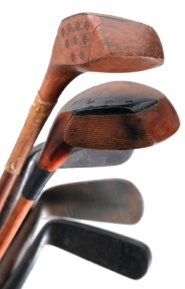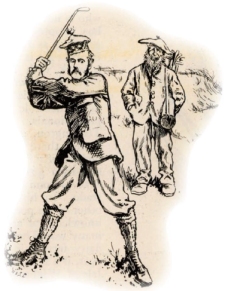Hickory-Shafted Clubs as Training Aids
 USGTF Southeast Region director Mike Stevens plays golf exclusively these days with hickory-shafted clubs, reminiscent of a much earlier era in our game’s history. Stevens loves the traditions of the game, and has often remarked how playing with hickory sticks has given him the most pleasure he’s ever had in the game. Stevens has had a lot of success playing with his hickory clubs, three times winning the National Hickory Championship, and several other tournaments, as well. It’s no surprise he speaks fondly of playing the game with the ancient implements.
USGTF Southeast Region director Mike Stevens plays golf exclusively these days with hickory-shafted clubs, reminiscent of a much earlier era in our game’s history. Stevens loves the traditions of the game, and has often remarked how playing with hickory sticks has given him the most pleasure he’s ever had in the game. Stevens has had a lot of success playing with his hickory clubs, three times winning the National Hickory Championship, and several other tournaments, as well. It’s no surprise he speaks fondly of playing the game with the ancient implements.
Most of us have never swung a hickory shafted club, which is a shame. The feel and performance are very different compared to what we have with our modern clubs. Hickory clubs have somewhat of a harsher feel at impact, although this is not to say that the feel is bad. Modern shafts and grips mute the feel of impact; hickory shafts and leather grips don’t, so the golfer gets the full feel of the clubhead impacting the ball. Performance-wise, hickory
shafts have much more torque (twisting properties) than do steel shafts, which means the clubhead tends to twist itself open on the backswing and twist itself closed on the downswing. A player using his normal steel-shaft swing to hit a hickory-shafted driver or fairway wood may find himself hitting big hooks. This tendency is not necessarily present in the irons.
Today, we can get clubs that fit our unique swing profiles, but with hickory, it’s the other way around – you must fit your swing to the clubs. This isn’t to say that all hickory clubs are the same; in fact, it’s quite the opposite. It seems no two hickory clubs have the exact same performance and feel. And, there are hickory shaft clubmakers today (as in the past) who make shafts in different flexes and clubheads with different specs, but the range of differences are much narrower than can be found with modern clubs.
With modern clubs, a golfer who is a slow, rhythmic swinger can find a shaft to perfectly match his motion, as can a golfer with a violent and quick move. Regardless of the shaft flex or clubhead design, a hickory player is forced to swing in a very rhythmic and unhurried manner if he wants to achieve any sort of solid strike and accuracy. It is still possible to attain a high clubhead speed with hickory clubs and maintain accuracy, as witnessed by Bobby Jones. It is said that his clubhead speed was in the ballpark of 115 miles per hour. However, if you look at movies of Jones, you will see a golfer who doesn’t even come close to making a quick or thrashing move at the ball. In Jones’ own words, “When a golfer has reached the top of the swing, it is the leisurely start down with the hands that provide for the gradual increase of speed, without disturbing the timing or balance of the swing.”
The use of hickory-shafted clubs is a wonderful way of smoothing out a player’s swing with modern clubs. USGTF national course director Mark Harman, who has played in several events with hickory clubs, stated, “I find that when I return to my modern clubs after playing with hickories, my tempo is much better, and my ballstriking is improved for the next few days.”
 Stevens, the resident USGTF expert on hickory play, echoed those thoughts. “Swinging hickory clubs requires much more attention to tempo, because the torque on the heads is a lot more variable than modern equipment and the shafts have significant bow during the downswing,” said Stevens. “Any mishit with hickories results in a much wilder shot, and the harder the swing, the worse the result, so hickory players tend to swing in a more controlled manner to keep the ball in play. As a result, after adapting to the more controlled swing with hickory clubs and then going back to modern clubs, it is only natural for players to swing easier and smoother at first. They hit the ball well.
Stevens, the resident USGTF expert on hickory play, echoed those thoughts. “Swinging hickory clubs requires much more attention to tempo, because the torque on the heads is a lot more variable than modern equipment and the shafts have significant bow during the downswing,” said Stevens. “Any mishit with hickories results in a much wilder shot, and the harder the swing, the worse the result, so hickory players tend to swing in a more controlled manner to keep the ball in play. As a result, after adapting to the more controlled swing with hickory clubs and then going back to modern clubs, it is only natural for players to swing easier and smoother at first. They hit the ball well.
Unfortunately, that does not last long, because the modern game is all about distance, and people tend to swing harder and harder the more balls they hit. All of a sudden, they start losing the rhythm that they developed with the hickory clubs.”
There are many wonderful training aids on the market today, but one of the best may be the implements of days gone by – the hickory-shafted club. Get a club or two, and you likely will be pleasantly surprised by the results you and your students get from them.




